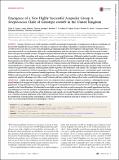Files in this item
Emergence of a new highly successful acapsular Group A Streptococcus clade of the genotype emm89 in the United Kingdom
Item metadata
| dc.contributor.author | Turner, Claire E. | |
| dc.contributor.author | Abbott, James | |
| dc.contributor.author | Lamagni, Theresa | |
| dc.contributor.author | Holden, Matthew | |
| dc.contributor.author | David, Sophia | |
| dc.contributor.author | Jones, Michael D. | |
| dc.contributor.author | Game, Laurence | |
| dc.contributor.author | Efstratiou, Androulla | |
| dc.contributor.author | Sriskandan, Shiranee | |
| dc.date.accessioned | 2015-07-30T15:10:03Z | |
| dc.date.available | 2015-07-30T15:10:03Z | |
| dc.date.issued | 2015-07 | |
| dc.identifier | 195839621 | |
| dc.identifier | ddff94e0-b138-43db-9a45-5a5708650773 | |
| dc.identifier | 84940856306 | |
| dc.identifier | 000360839400026 | |
| dc.identifier.citation | Turner , C E , Abbott , J , Lamagni , T , Holden , M , David , S , Jones , M D , Game , L , Efstratiou , A & Sriskandan , S 2015 , ' Emergence of a new highly successful acapsular Group A Streptococcus clade of the genotype emm89 in the United Kingdom ' , mBio , vol. 6 , no. 4 , e00622-15 . https://doi.org/10.1128/mBio.00622-15 | en |
| dc.identifier.issn | 2150-7511 | |
| dc.identifier.other | ORCID: /0000-0002-4958-2166/work/60196414 | |
| dc.identifier.uri | https://hdl.handle.net/10023/7083 | |
| dc.description | This work was supported by the National Institute for Health Research Biomedical Research Centre awarded to Imperial College Healthcare Trust, and the UK Clinical Research Collaboration (National Centre for Infection Prevention & Management). | en |
| dc.description.abstract | Group A Streptococcus (GAS) genotype emm89 is increasingly recognized as a leading cause of disease worldwide, yet factors that underlie the success of this emm-type are unknown. Surveillance identified a sustained nationwide increase in emm89 invasive GAS disease in the UK, prompting longitudinal investigation of this genotype. Whole genome sequencing revealed a recent dramatic shift in the emm89 population with the emergence of a new clade that increased to dominance over previous emm89 variants. Temporal analysis indicated that the clade arose in ~early-1990s but abruptly increased in prevalence in 2008, coinciding with increased incidence of emm89 infections. Although standard variable typing regions (emm-subtype, tee-type, sof-type and MLST) remained unchanged, uniquely the emergent clade had undergone six distinct regions of homologous recombination across the genome compared to the rest of the sequenced emm89 population. Two of these regions affected known virulence factors; the hyaluronic acid capsule and the toxins NADase and streptolysin O. Unexpectedly, and in contrast to the rest of the sequenced emm89 population, the emergent clade-associated strains were genetically acapsular rendering them unable to produce the hyaluronic acid capsule. The emergent clade-associated strains had also acquired a NADase/ streptolysin O locus near identical to that found in emm12 and modern emm1 strains but different to the rest of the sequenced emm89 population. The emergent clade associated strains had enhanced expression of NADase and streptolysin O. The genome remodelling in the new clade variant and resultant altered phenotype, appear to have conferred a selective advantage over other emm89 variants and may explain the changes observed in emm89 GAS epidemiology. | |
| dc.format.extent | 11 | |
| dc.format.extent | 2760570 | |
| dc.language.iso | eng | |
| dc.relation.ispartof | mBio | en |
| dc.subject | R Medicine | en |
| dc.subject | QR Microbiology | en |
| dc.subject | DAS | en |
| dc.subject.lcc | R | en |
| dc.subject.lcc | QR | en |
| dc.title | Emergence of a new highly successful acapsular Group A Streptococcus clade of the genotype emm89 in the United Kingdom | en |
| dc.type | Journal article | en |
| dc.contributor.institution | University of St Andrews. School of Medicine | en |
| dc.contributor.institution | University of St Andrews. Infection Group | en |
| dc.contributor.institution | University of St Andrews. Biomedical Sciences Research Complex | en |
| dc.identifier.doi | https://doi.org/10.1128/mBio.00622-15 | |
| dc.description.status | Peer reviewed | en |
This item appears in the following Collection(s)
Items in the St Andrews Research Repository are protected by copyright, with all rights reserved, unless otherwise indicated.

